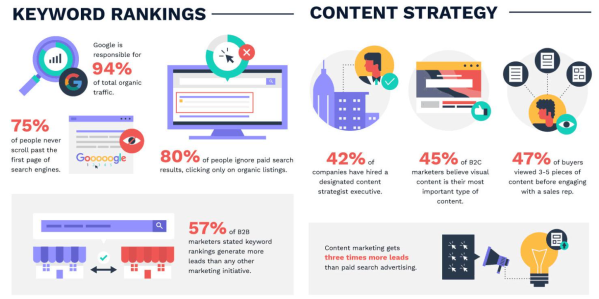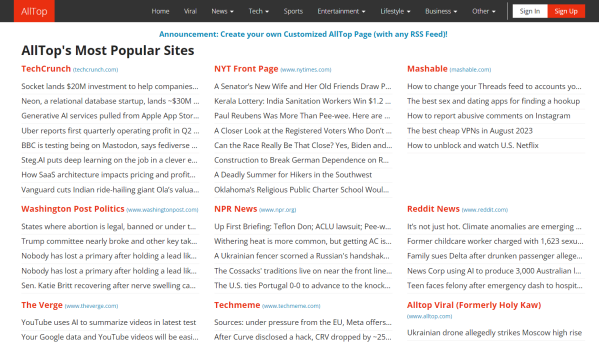
In today’s digital landscape, where information overload is a constant challenge, bloggers face the task of standing out amidst a sea of content.
Crafting stellar blog posts requires a delicate balance of creativity, expertise, and time. However, there is a powerful technique that can streamline the process and deliver valuable content to your readers without reinventing the wheel — blog content curation.
Whether you’re a seasoned blogger looking to enhance your writing or a beginner seeking effective ways to engage your audience, blog content curation holds the key to unlocking your blogging potential.
What is blog content curation?
Blog content curation refers to gathering and organizing content from various sources and publishing it to your blog.
It allows you to leverage the expertise and insights of others, saving you time and effort while still delivering valuable content to your readers. But content curation walks a delicate tightrope, balancing the value of sharing information while respecting the original creators and their rights.
Blog curation is not limited to written articles. It can include a range of content formats, such as videos, infographics, images, and social media posts.
Blog content curation examples
If you’re looking for samples to get a better idea of how to curate blog content, then here are five blog-content curation examples for business:
Roundup posts
A common form of blog curation is creating roundup posts. These posts gather and highlight a selection of top articles, videos, or resources from various sources on a specific topic.
For example, a marketing blog might curate a roundup post featuring the best social media marketing articles of the month, providing readers with a valuable collection of insights and tips from different experts.
Trend analysis
Bloggers can curate content to provide a comprehensive analysis of a specific trend or topic. This involves gathering relevant articles, research reports, case studies, and examples to present a well-rounded view of the subject.
For instance, a fashion blog might curate content exploring the latest sustainable fashion trends, including articles on ethical brands, eco-friendly materials, and sustainable fashion practices.
Expert insights
Another example of blog content curation is featuring expert insights. This involves curating content that showcases the thoughts, opinions, or advice of industry experts or thought leaders. It could be in the form of interviews, quotes, or guest contributions.
Take, for instance, a technology blog that might compile a series of interviews with leading scientists in the field, offering readers unique perspectives and expertise.
Infographics and visual content
You can also create informative blog content by aggregating information from several sources into visually appealing infographics.

If, for instance, you have a health and wellness blog, you could put together a selection of infographics on different exercises, healthy recipes, or mental well-being tips.
This form of content curation is a great way to provide easily consumable information and enhance the visual appeal of your blog. It is also a clever way to boost user engagement and the sharing potential of your content.
Case studies
Another example of content curation for business is presenting case studies. You can create a list of real-life examples of success stories from companies or individuals within a specific industry. By showcasing these case studies, you can provide valuable insights and practical lessons to your readers.
For instance, a business blog could curate a series of case studies that highlight how different companies successfully implemented a specific marketing strategy, improved their customer service, or achieved significant growth.
The options are endless! And the process of creating a curated blog typically includes selecting relevant content, adding value or context to it, and presenting it in a way that is relatable to your audience.
Why curate content for blog posts?
The goal of blog content curation is to provide a collection of high-quality content to your audience, helping them find valuable information faster. Other benefits of blog curation include:
It helps you get quality content out faster
Instead of starting from scratch to create all the content yourself, curation allows you to tap into existing high-quality content from various sources. It eliminates the need for extensive research on a topic since you are leveraging existing content that has already been thoroughly researched and vetted by the original creator.
It can help improve your blog’s visibility with backlinks
When you curate pieces of content and include proper attribution to the original sources, you create opportunities for those sources to discover your blog and potentially link back to your curated posts.
By consistently curating high-quality content, you can establish yourself as a trusted resource within your niche. This increases the chances of receiving backlinks from other websites looking to reference or share your curated content. These backlinks not only drive referral traffic to your blog but also contribute to your search engine optimization (SEO) efforts.
It helps you stay on top of industry trends
As a curator, you actively search for and discover the latest articles, reports, studies, news updates, and discussions related to your niche. Through the process of blog curation, you become aware of emerging topics within your industry.
A content curation blog strategy enables you to stay informed, adapt your content marketing efforts, and position yourself as an authoritative source that is up-to-date with the latest industry trends.
It builds and maintains an engaged audience
When you create curated blog content, you have the opportunity to add your own insights, commentary, or context to the curated pieces. This personal touch enhances the reader experience and encourages engagement.
Sharing your thoughts, opinions, or analysis alongside curated content can prompt your audience to participate in discussions, leave comments, and share their perspectives.
This interaction fosters a sense of community and establishes a two-way communication channel between you and your readers, resulting in a more engaged audience.
It positions you as a knowledgeable thought leader
As a curator, you can identify patterns, connections, or emerging themes across curated content. By presenting these insights to your audience, you show that you provide trustworthy information, boosting your authority within your niche. This way, you attract a loyal following of readers who look to you for valuable insights and guidance.
How to curate content for your blog
There are a few best practices for curating content that can guide you successfully through the process. Let’s look at four of them.
1. Choose reliable sources for original content
Select trustworthy sources to ensure the accuracy and credibility of your blog. If you’re looking for statistics or data-backed information, retrieve it from the primary source. Primary sources refer to the original research studies, reports, or official data released by academic journals or publications from authoritative organizations or industry experts.
While secondary sources such as news articles or blog posts may summarize or interpret data, they can sometimes introduce errors or misinterpretations.
Look for sources that provide well-researched articles and up-to-date information. It will help you build trust with your readers and establish yourself as a reliable source of information.
2. Add your own thoughts and annotate your sources
Curating content doesn’t mean simply copying and pasting information from other sources. It’s important to add value to the content by sharing your unique perspective and insights.
After gathering information from your chosen sources, take the time to analyze and interpret the content. Add your thoughts, opinions, and analysis to the curated piece, giving your readers a fresh perspective or additional context.
Indicate the original source of the information you’re presenting to give credit to the creators and avoid plagiarism. Doing this builds credibility and allows your readers to explore the topic further as they wish. Regularly review and refresh the resources to ensure they remain accurate.
3. Compile a list of aggregated content
The goal of aggregation is to collect a diverse range of content that provides different perspectives, insights, and opinions on the chosen subject matter. So, you’ll want to create a structure for your aggregated content list.

Group similar resources together based on subtopics or categories. This content can include articles, blog posts, videos, podcasts, infographics, and social media posts.
Aggregation can be done manually by conducting thorough research and exploring different platforms, blogs, news sites, and social channels. Alternatively, you can use content curation tools that help streamline the process by listing content pieces based on keywords or topics.
4. Properly cite your content sources
Plagiarism can inadvertently seep into article curation if proper precautions are not taken. To steer clear of this pitfall, always provide due credit and attribution to the original sources and creators of the curated content. Make sure to include accurate references within your post, following the appropriate citation style depending on the nature of your blog.
When you mention a specific source, particularly when it’s an online article, blog post, or website, include a hyperlink to the original content.
For example, if you’re discussing a recipe from a food blog, you can include a URL within the text like this: “I found a delicious recipe for chocolate chip cookies on [Blog Name] that’s worth checking out!” The linked text could be the name of the blog or a specific keyword related to the content.
This helps maintain transparency, avoid plagiarism, and showcase your commitment to integrity and ethics in content creation. Providing clear citations also allows your readers to verify the information.
Blog content curation vs content creation: what’s the difference?
Content curation is different from content creation, where you generate original content from scratch.
With content curation, you act as a filter, sifting through the vast amount of existing content on the internet to present the most relevant and valuable pieces to your audience.
Content creation, on the other hand, involves producing unique content that hasn’t been published before. It requires brainstorming ideas, conducting research, organizing information, and crafting fresh articles for your audience.
Content curation and content creation are not mutually exclusive. In fact, they can work together synergistically to enhance a brand’s content marketing efforts.
Content creators can supplement their original content with curated content, providing additional value and perspectives to their audience. Content curators can also create original content to complement their curated collections and share their own insights and analysis.
Ultimately, whether you choose to focus more on content curation or content creation depends on your brand’s goals, available resources, and the preferences of your target audience. Finding the right balance between the two can help you provide a well-rounded content experience that educates, engages, and nurtures your audience.
Power your digital marketing strategy
Now that you’ve learned about the value of content curation for digital marketers, it’s time to take your digital marketing strategy to the next level. By leveraging content curation, you can save time on content creation, offer diverse perspectives to your engaged readers, and boost your SEO efforts effectively.
If you’re new to blogging or want to expand your reach with blogging, first decide the niche you’ll be curating content in and the writing style you’d like to use to connect with your audience. Then utilize content curation software or consult an online marketing professional to help streamline your process.
With these amazing strategies in your arsenal, get ready to witness your digital marketing endeavors taking flight!




